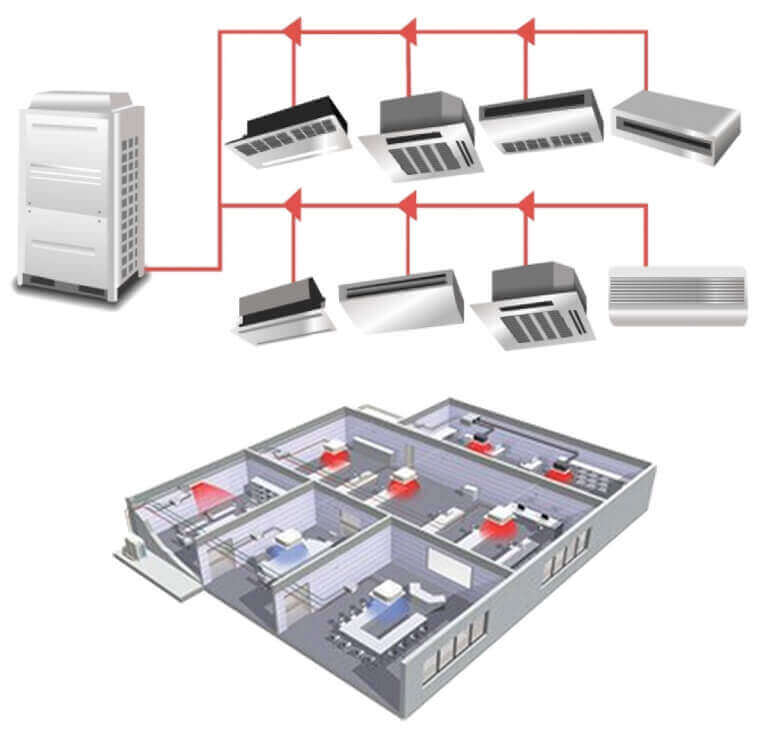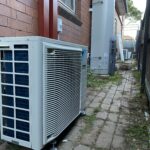The continuous development of residential and non-residential air conditioning equipment has led to the emergence of equipment that has “VRV" in its name. This means “Variable Refrigerant Volume" – variable refrigerant flow rate.
So what is the meaning of such a device? VRV air-conditioning systems are climatic equipment, designed for servicing large areas, apartment and house buildings. What distinguishes such devices from conventional split systems is their installation and the price not only for buying an air conditioner, but also for its maintenance.

The VRV system in its principle of operation is almost no different from the usual split system. The same as in a usual air conditioner, multizone equipment is based on the process of refrigerant circulation in the compressor-condensing unit (CCU).
VRV air conditioners differ only in the fact that a number of indoor units can be several. More often they are not even blocks, but special ceiling grids, connected to the mains. So in the external block there are several evaporators per one condenser.
Key Takeaways
- VRV systems have multiple indoor units connected to one powerful outdoor compressor unit. Good for large commercial spaces.
- Benefits vs regular split ACs: Serves multiple zones, energy efficient, flexible control, easy expansion, redundancy if one unit fails.
- Consider number of zones, room sizes, usage patterns to size system capacity and refrigerant piping. Complex sizing calculations needed.
- Outdoor units are large and noisy, typically located far from building on ground or rooftop. Piping can reach 30-40m from unit to indoors.
- Indoor unit types: cassettes, floor mounts, wall mounts. Cassettes popular for unobtrusive ceiling integration.
- Regular maintenance improves efficiency – cleaning filters, checking refrigerant levels, inspecting drain system. Requires HVAC professionals.
- Installation also needs specialized technicians for complex piping, wiring, zoning configuration. Not a DIY job.
- Leading brands: Daikin, Mitsubishi Electric, LG, Fujitsu, Toshiba. Commercial-scale systems with premium price tags.
- Consider efficiency, number of connectable indoor units, control integration, warranty terms when selecting models.
- VRV systems are complex commercial solutions for large-scale zoning and efficiency. Overkill for typical homes.
In a split system, the outdoor unit is always compact and not loud in operation. And in a VRV system such characteristics are not observed. This kind of equipment is powerful, absorbing dozens of kilowatts of electricity during 1 hour of its operation.
There is a big flow of heat from the fan. Even the sound of a multizone conditioner is several times more in number of dB than even the most powerful domestic equipment. That is why the VRV air-conditioning system, or rather its outdoor unit, is installed at least 10 meters from the perimeter of the building.

The device of multizone climate equipment has several variations. Most often they are related to the type of the indoor unit. Such can be: cassette, floor, hinged, etc. Applying one or another variant for a premise, usually guided by the amount of space for the air conditioner.
More often the systems with a cassette indoor unit are in demand. Such one does not take so much space and is executed in the form of device-jammer. But everything is not so easy, because under a neat kind of equipment, under the ceiling, there is a volumetric mechanism. And the line itself with the refrigerant is spread like a spider's web over the building or separate floor.
Advantages of installing VRV system

Multizone system – a complex mechanism that has a lot of advantages and almost no disadvantages. Some of its advantages include:
- Possibility to serve a multi-storey building with several outdoor units.
- Installation of VRV systems. It is easier to distribute thin routes with refrigerant and to separate zones of a room, as compared to duct ventilation, which is dozens of times more voluminous.
- Power Consumption. If to equip a multistorey premise with a necessary amount of ordinary split-systems, the power consumption will be 3-4 times more than if using multi zone equipment.
- Multifunctionality of control of one conditioner. For example, it is possible to set separate mode and temperature values on each separate indoor unit which will be different from other devices connected to the outdoor unit.
- Backup air conditioning. If one indoor unit fails, operation of the entire air conditioning system will not be disturbed. And the failed unit will be duplicated by another unit that is switched on.
- Translated with www.DeepL.com/Translator (free version)
Expansion of the air conditioning system is possible with the additional connection of one or more additional trunks.
Designing VRV systems
Designing an air conditioning system is one of the most important preparatory steps before purchasing equipment. During such activities, it is important to correctly calculate how much piping is needed for the effective operation of the device. It is also important in the design to take into account:
- microclimatic parameters;
- the parameters of thermal loads;
- the desired temperature change parameters.
Independently performing such actions is difficult, and sometimes impossible because of the need for specialized equipment. So, using electronic computers and special programs, specialists must calculate
- optimality of thermal modes;
- power consumption;
- the necessary power of separate modules.
But such work can be simplified. Specialized companies, which are involved in installation of VRV air conditioners with circulating refrigerant, often have projects already calculated for certain conditions and possess relevant documentation certified by required instances. Thus, installation of VRV systems comes faster.
The installation of VRV system
The whole system of multizone equipment can include dozens of external units. Thus, modern models have the ability to connect up to 40 lines. But this is not the limit of such equipment. Producers of climate equipment are constantly making adjustments to their models. So, some of the most expensive units have the ability to effectively cope with the work of more than 90 points simultaneously.
Like the cost of the air conditioner, its installation is also expensive. You will not be able to connect the equipment yourself. Only specialists are involved in such activities.
The installation must be error-free. The complexity of VRV system installation is in the complex structure of pipelines. And the separate connection of one unit to the outside unit does not differ from the installation of the apartment split-system.
VRV system external unit location
Correct installation of the external unit is also important. The sound of engine and fan operation should not be heard in the room. That is why such systems are often remote from the perimeter of the building by 10-30 meters.
The more powerful the model itself, the further the unit will be installed. For several trunk channels, 7-10 meters is enough. In addition to discomfort from the sound, this is due to the fact that the length of the copper line can not exceed 30-40 meters.
There is also another variant – the roof of the building. Such a location of the air conditioner will not bring discomfort to the users of the equipment. So, the only disadvantage will be the inconvenience of fixing the equipment on the roof.
The roof of a building is not the only alternative place to install an air conditioner. Sometimes the architectural structure of the roof makes it impossible to place large and heavy equipment. If a heavy metal frame is used, it can be suspended like a normal outdoor unit. Placing the equipment on the wall is not the best solution to the problem, but sometimes it is the only option available.
The location for the outdoor unit is always determined based on several factors, such as:
- Structural features of the building itself (walls and roof);
- The availability of free privatized area near the building;
- The presence of residential buildings in the vicinity of the planned location and the distance to them.
Choice of location under the external unit VRV system is better to trust professionals. Such people are often faced with solving such issues for a long time, so their opinion will be the most important.
VRV systems maintenance
VRV air conditioners require regular maintenance. Such measures are important for quality and efficient operation of the equipment. Also the service life of the air conditioner itself will increase. And also maintenance that is carried out regularly, helps to save energy. On your own, without some experience of such work and special equipment – you can not conduct inspections.
The very concept, air conditioner maintenance, includes a set of activities of various kinds. Often required are:
- replacement and replenishment of consumables;
- inspection of the A/C unit;
- inspection of electronic equipment;
- cleaning of filter inserts;
- verification of room heating or cooling efficiency;
- calibration of important components of the outdoor unit;
- checking the operation of the
- drainage system.
If climate systems are equipped with a special control panel (cabinet or computer), then specialists can examine the operation of the air conditioner for malfunctions and errors in the entire system.
This “brain" of the VRV unit allows you to control the operation of each individual piece of equipment. It only requires special software. If you have such a control panel, it will not be difficult to adjust the operation of the air conditioner. Even for the user.
Interesting tips about VRV
Technologically speaking, multizone air conditioning systems are categorized by certain numbers – 1-3. Each such equipment is an improvement on the first modification. One of the most popular types of multizone air conditioners is considered VRV II. The second modification has more economical characteristics, compared to VRV I.
Development of the second generation of air conditioners has influenced the creation of 11 variants of the schematic complex of the device. Such ones work on the refrigerant “freon R410A" and give out up to 135 kW capacity. And the number of produced modifications of other capacity – more than 50.
It is important that operation of multizone conditioners can be based not only on air cooling. Even water systems are used for the second generation VRV. They have an important advantage over air systems – the ability to work effectively in all weather conditions.
The third generation VRV is no less known for its characteristics. It is with this type of air conditioning system that equipment can work efficiently even when the outdoor unit is located 165 meters away from the building itself. And one such outdoor unit can use up to 20 highways.
VRV equipment is not only used in climatic devices. Active development and popularity of this system influenced the creation of special tanks for storing liquefied substances. They are very similar to the usual cylinders, but differ in their technical components. Also under the influence and expansion tanks, of which some manufacturers make hyperaccumulators for heating and air conditioning systems.
Usually such devices are used to maintain the necessary level of freon in closed systems.
VRV Systems FAQ
What is difference between VRV and VRF?
VRV stands for “Variable Refrigerant Volume," while VRF stands for “Variable Refrigerant Flow". VRF refers to the same basic technology used in those systems manufactured by other companies—Fujitsu, for one, makes some great variable refrigerant flow systems.
What VRV stands for?
Variable refrigerant flow (VRF), also known as variable refrigerant volume (VRV), is an HVAC technology invented by Daikin Industries, Ltd. in 1982. Like ductless minisplits, VRFs use refrigerant as the cooling and heating medium.
What is the difference between VRF and HVAC?
First, these systems only use refrigerant to create cool air. Compare this to a traditional HVAC system that uses water to cool the air. VRF systems have multiple air handlers that can be connected together within the same refrigerant loop.
What is difference between VRV and chiller system?
VRF Systems are much more flexible and efficient in providing precise control and comfort. These systems are quite convenient as they have smaller footprints. When compared to the Water chiller system, VRF Systems are quite easy to install and less expensive.







